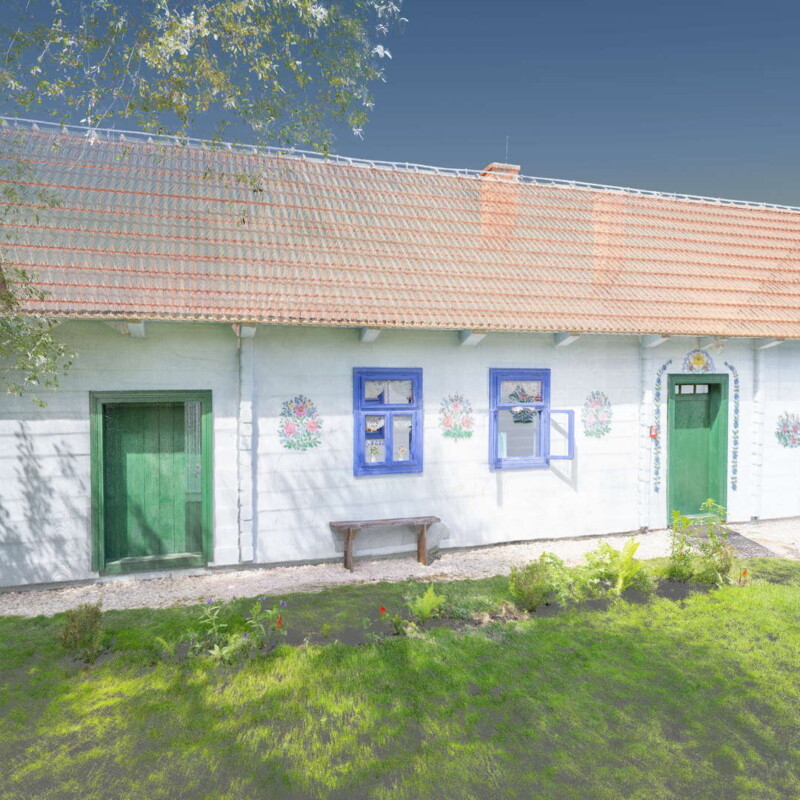Felicja Curyłowa’s Painted Cottage, Zalipie
Zalipie is a village in Małopolska, famous for its cottages painted in colourful, floral patterns. Interest in Zalipie began thanks to the famous local painter –Felicja Curyłowa (born in 1903, died 1974), who, apart from her artistic skills, proved equally effective at promoting the reputation of the village. Zalipie, located in Powiśle Dąbrowski district, quickly gained fame as the “painted village”. The custom of painting patterns on houses and farm buildings, dates back to the 19th century, and can be seen not only in Zalipie, but also in other places in Powiśle and even elsewhere in Poland.
The artist’s house was visited by many during her lifetime and became the most important pilgrimage place for all lovers of folk art. Interest in folk-culture intensified particularly after World War II, when rural handicrafts were promoted by local authorities.
Felicja Curyłowa was even invited to paint the interior of the Batory ocean liner and the famous Wierzynek restaurant in Krakow. The folk decoration style popularized by Felicja Curyłowa dates back to the times of smoky cottages lacking even a chimney, where the smoke from the hearth had to escape through an opening in the roof.
The walls inside such a smoky hut were often covered with soot, so in order to brighten the interior, the housewives painted white patches on the walls with lime. After chimney stoves became popular, these patches were also painted on the stoves. With time, they were replaced by floral motifs, which also dominated the walls and ceilings of rooms, and finally the outer walls of houses and farm buildings. In addition to buildings, roadside figurines, wells, fences and vessels began to be decorated in this way.
Application – a virtual walk around the object
Zalipie is sometimes called the village painted in flowers. And no wonder, since not only houses and barns, but also the wells, fences, and dog kennels are covered in painted flowers. Of greatest interest is the farm of Felicja Curyłowa herself. The original farm consists of Felicja Curyłowa’s house, a stable and a barn. These buildings are arranged in a U-shape, which is open to the road. Standing with your back to the road, on the left side of the farm is the house of Curyłowa, with an old stable opposite, and the barn building to the right.
Two more historical listed buildings can be found in the old farm estate, dating back to the 19th century – the house which belonged to Stefania Łączyńska, which is past Curyłowa’s cottage and the stable, and, a dozen or so metres to the right of the barn stands the building which was known as the Pauper’s Cottage. Felicja Curyłowa’s house was built in 1908 and is clad with vertical, yellow-painted boards of wood which form a bright yellow background for the blue shapes painted on top, such as the window frames – painted in an intense blue.
The door, decorated in dark brown with blue diamond-shaped decorations, with three vertical strings of pale blue flowers trailing on either side of the entrance. Each grows from a stem with leaves. The petals of the flowers spread out in a circle. The pink walls of the stable are decorated with large bouquets of blue flowers in bulging vases. The barn is clad with dark brown planks of wood. Łączyńska’s house and the Pauper’s Cottage are whitewashed and decorated with typical Zalipiean patterns.
On the sides of the blue-framed windows and blue doors of the Łączyńska house, bouquets of large and small flowers are painted.
Red, pink, blue and yellow flowers emerge from green leaves. On the sides of the windows, blue forget-me-nots bloom on vertical branches. Above the frame, red and blue clusters of flowers are painted. On the walls of the Pauper’s Cottage the floral patterns rise higher than the windows.
Between the green leaves the flowers shimmer red, blue, pink and sunny yellow. In spring, summer and autumn the patterns on the Zalipie cottages blend charmingly with the various species of real wildflowers growing in the surroundings.
The interiors of the houses comprising the Curyłowa farmstead are adorned with in an almost overwhelming array of painted flowers, drawn with a remarkable simplicity with extraordinarily vivid colours. However, you can easily recognise individual species, such as yellow sunflowers and pink peonies. The flowers seem to burst out on the whitewashed walls of the kitchen stove, on large and small kitchen items, and on the white walls, where they surround priceless family photographs.
While visiting this artist’s house you can also admire a folk costume that she made, which consists of a skirt, an apron, a waistcoat, a blouse and a head scarf. The green, floral-patterned skirt has an apron, half-embroidered with a band of colourful flowers. The red waistcoat has black inserts. The white blouse is covered with colourful embroidered flowers. Red beads and a red head scarf complete the outfit.















